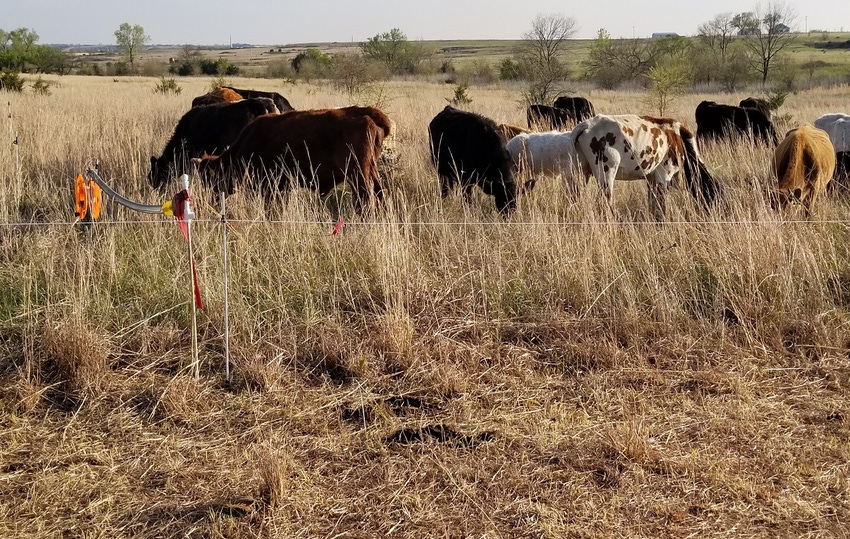
For the past two and a half years, I have been struggling to achieve ultra-high density grazing together with non-selective grazing.
The rewards are great. For example, I’m already at triple stocking rate or a little above and am arguably understocked most of the time. The land and forage is improving quickly. The difficulty is balancing the pressure I am trying to put on the forage/soil with the needs of the cattle.
This is especially troublesome with the hard-doing, heat-intolerant cattle that are standard today. I will write more about that in my next blog, but I’ll share today a bit more about the effects I have previously described that we can expect from high-stock-density grazing and those I’m seeing on the ground.
The addition of “non-selective grazing” to the stock-density piece of the puzzle is the newest twist in grazing management, and I think it is the logical progression. Non-selective grazing takes or tramples as close to all the forage as possible. It requires the cattle to eat much deeper into the forage, across more species, than we’ve typically thought customary or reasonable. Selective grazing allows them to select, whether under continuous grazing or some form of rotation. The stock density alone does not create selective or non-selective grazing. It is the consumptive requirement the manager puts on the cattle. And therein lies the struggle.
As I’ve written many times in recent years, the pioneer of this thinking and method is Johann Zietsman. He describes his experiences in his book, Man, Cattle and Veld.
Ziestman’s story
“On January 12, 1995 I implemented Ultra-High-Density Grazing on my property near
Karoi, Zimbabwe,” he writes. “Within a matter of weeks stocking rate was doubled, in the driest year on
record, owing to improved veld utilization. Two years later stocking rate was treble the norm. In
2002 it was possible to carry four times the norm.”
He went on to develop a more efficient cattle type before his ranch was nationalized by the Zimbabwean government. They were smaller-framed, much thicker, hormonally balanced, parasite resistant and highly reproductive. As Zietsman describes it, this was hugely beneficial in his work to increase non-selectivity under ultra-high-stock-density grazing.
This non-selectivity issue is a huge contributor to developing grasslands, from what Zietsman describes and from what I can tell.
In his book, Zietsman shows pictures of two monitoring sites on his former ranch. In successive years he changed the grazing management between selective and non-selective and back again and saw huge changes in productivity and in species composition, which can be a big contributor to quality.
Big change
The photos were taken at the same monitoring site a year apart in the middle of the wet
season. Even a casual observance indicates a massive change in both species and mass of grass after two treatments of high animal Impact and non-selective grazing. Physical monitoring showed a decrease in unpalatable species from 86.0% down to 46.0%. Highly palatable species increased from 4.5% to 26.0%. The spacing between perennial grass plants decreased from 3.5 inches to 2.2 inches, therefore creating greater plant density. The proportion of young perennial plants (seedlings) increased from 0% to 78.0%. The precursors to this change were altered soil surface conditions and accelerated recycling of plant material, he says. The rapid rate of change was partially due to high seasonal humidity, which he says was 39.4 inches of rain from mid-November to mid-March.
Going backward
In the second set of two photos at the same locations, Zietsman shows how the progress in species change in these locations made after just one year was reversed from 26.0% back to 10.0% palatable species after just two years. The reason for this was selective grazing over a large area during the growing season. He says the management was changed back to non-selective grazing and high-density grazing, again creating positive results.
In my own operation, I do not have monitoring sites, other than two NRCS-established transect lines and multiple GPS-marked soil sampling locations. However, I pay close attention to the forage and I’m seeing trends toward much denser plant spacing and higher leaf material, as well as increases in mid-grass species and tallgrass species.
I’m sad to say the areas that were farmed many years ago are slowest to recover, even with this management. Yet changes are happening there, too.
All over the world, people are working at this management and succeeding. The land progress is rapid, but the change in cattle type is slow.
In my next blog I’ll write about how cattle performance, or lack of it, is the most difficult aspect of this management technique. Read that here.
About the Author(s)
You May Also Like




